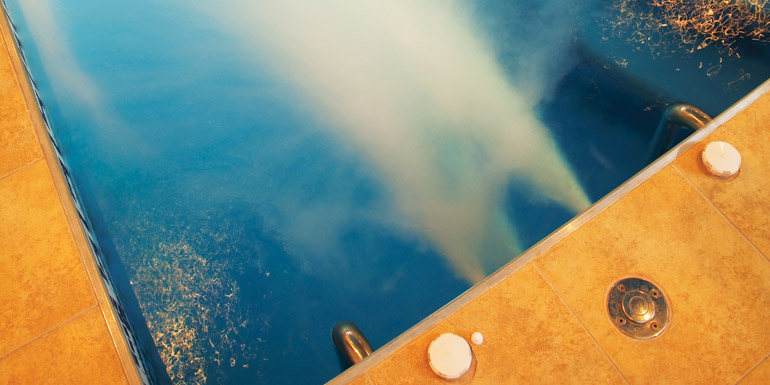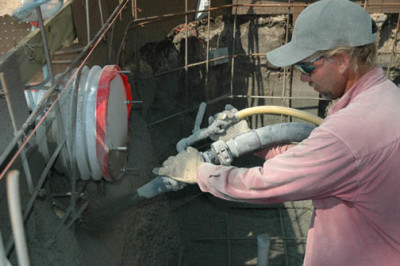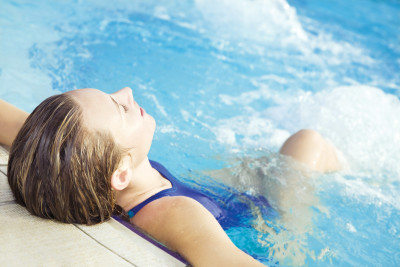Swim jet systems
by Sally Bouorm | January 1, 2010 3:47 pm
 [1]
[1]By Jeff Sanchez
Today, pools are more than a wonderful conversation piece; for many, they represent the fulfillment of a backyard dream. However, as the population ages, more pool owners are looking to add an element of practicality to that dream.
As the aging ‘baby boomer’ generation looks for convenient, low-impact exercises to keep their bodies and minds healthy, many pool owners are opting to add a swim system to their existing pool, while others are choosing the utility of a swim spa. While they are often added to an existing pool or spa, swim systems are also becoming popular add-ons during the design stage.
Swim systems create a stream or current of water within an otherwise still water environment. They provide a treadmill-like workout to a swimmer, walker or jogger, with the user working against the current for added resistance. The aquatic environment has less impact on the body, resulting in greater health benefits in a shorter amount of time and with reduced injury risk.
There are several swim system options currently on the market. Most manufacturers use one of three systems to produce current, each delivering a slightly different experience. The paddle-wheel system pulls water back and generates a gentle current, with the water returning underneath the current. Another option is a propeller-based system, which produces a steady, even, wide-reaching current with minimal energy expended. The third option—nozzle systems, which are commonly referred to as swim jets—will be the focus of this article.
What are swim jets?
The swim jet system was developed in Europe, where aquatic fitness has long been an aspect of the typical swimmer’s lifestyle. Swim jets are nozzles that direct a strong stream in the pool, producing a flow in excess of 18,927 L/min (5,000 gal/min). They can be found in pools and swim spas, incorporated either during the design phase or installed on an existing pool or spa as part of a renovation.
Compared to other systems, swim jets allow greater freedom to adjust the depth and width of the current. For adult users, swim jets allow any pool to be transformed into a lap pool, spa or aerobic workout centre. Children can also benefit from the system, which can add an element of fun and create a swimming experience reminiscent of a water park. Swim jets can create the equivalent of a lap swimming pool in a much smaller space than a standard lap pool, an advantage given the decreasing size of residential backyards. This makes swim jets ideal for selling as an add-on feature.
In addition to providing resistance for swimming or walking exercises, the stream created by swim jets can also provide a massage for tired, aching muscles. The stream intensity can be controlled by turning the jet nozzle, adding or subtracting air in the stream of water or by the swimmer’s distance from the nozzles.
Swim jet systems are generally made up of the following parts: jets or nozzles, a pump (or pumps) and a plumbing and electricity supply control. As many as three swim jets can be added to a system allowing for the creation of a very wide swimming lane. The systems can be installed in many types of spas and pools, including concrete, vinyl-lined and fibreglass models.
Today’s swim jets are not only fun, they are also safe, as the suction and return of water are contained in the same housing. In fact, some swim jet combination hydrotherapy fittings, with suction and discharge in one housing, are listed in the ANSI/ASME Standard for Suction Fittings, the standard that forms the basis for the Virginia Graeme Baker Pool and Spa Safety Act (VGBA). The ANSI/ASME is the standard that describes the swim jet as a combination fitting.
Pumps and placement
To produce a wide swimmable stream of water, one must first determine the proper pump size. Most systems on the market today incorporate a pump hydraulically designed to produce the proper amount of flow through the nozzle, resulting in a smooth stream of water. Mixing and matching different pumps with different nozzles may not result in the swim experience the customer is expecting. Installers must ensure the pump has been designed for the entire swim system.
An advantage of a swim jet system is that the pumps and jets are independent of the circulation pump and can be turned on and off at will. Swim jet pumps are very similar to standard swimming pool pumps, but are designed to match the flow requirements of the nozzles. Given these similarities, pump maintenance is easy and straightforward. Any properly trained pool and spa pump service person can maintain a swim system; there is no need for specialized tools or equipment.
Once pump needs are determined, proper placement of the jets is needed to ensure optimum results. In general, it is best to install jets at one end of the pool. A side-wall installation can work, but there must be at least 4.2 m (14 ft) of pool clearance from the jets (or at least twice the length of the swimmer’s body). Jets should be placed in a part of the pool that is no deeper than 1.2 m (4 ft). The centre of the jet nozzle should be about 254 mm (10 in.) below the water surface.
New construction
During the design phase, swim jet placement can be maximized for optimum swimming and pool aesthetics. There are many options for jet placement, quantity, type and colour. In addition, proper plumbing and electrical supply can easily be factored in before construction begins and customer expectations can be more easily managed.
Any size pool or spa is a candidate for swim jets, though some manufacturers suggest a minimum pool width of 2.1 m (7 ft), length of 4.2 m (14 ft) and depth of 1.1 m (3.5 ft) to allow sufficient swimming space. The extra length allows the swimmer to comfortably drift back and swim upstream. Of course, builders should always consult local codes for minimum distance between the system pump and pool.
 [2]
[2]On some systems, when the distance between the jet housing and pump is 9.1 m (30 ft) or less, it is recommended to use 101-mm (4-in.) pipe. On runs longer than 9.1 m, 152-mm (6-in.) pipe is recommended. Proper pipe size allows for the right amount of flow based on the swim jet design.
An air regulator is included with most swim jet systems, enabling the swimmer to boost the amount of air in the swim current. More air in the stream can provide more resistance. The air regulator can be installed anywhere, as long as it is not continuously flooded with water.
Once planning and preparation are complete, a swim system with one, two or three jets should take about a day to install. The jet housing should be encased with gunite; at least 50 to 76 mm (2 to 3 in.) of plumbing stub out should also be covered with gunite.
Swim jets can be easily installed in a liner or fibreglass pool. The installation process is similar to the gunite process. After completing a cutout in the pool, the swim jets are mounted and screwed into the pool wall. Plumbing and electrical details are similar to a gunite installation. In addition, some systems have the ability to tie into automated pool and spa control systems.
Existing pools
Many of the estimated 8 million pools in North America and are excellent candidates for a retrofitted system jet system. A retrofit system can be mounted over the wall of most pools and comes with the pump, jet, control box and mounting hardware. The advantage of a retrofit swim system is that it requires no additional equipment. The installer only needs to figure out proper placement and find an adequate electrical supply. These systems can be easily installed because it comes in a compact one piece molded body and has not protruding parts ensuring pool users’ safety.
 [3]
[3]When installing a swim jet system on an existing pool, one must take into consideration existing features that may limit jet placement options. Also, an over-the-deck retrofit swim jet system typically comes with only one jet. A retrofit in-wall system can be added to existing concrete or gunite pools, though some extra work and renovation will need to be completed.
For an over-the-wall swim jet system, it is recommended that distance between the retrofit swim system unit and the control box be at least (5 ft). Some items to consider when placing a retrofit swim system on a pool are:
- Location of the main wiring and service pane;
- Distance between the unit and its control box;
- Location of an installation point that provides plenty of space, allowing people to easily walk around the swim system;
- Pool size. Much like new construction systems, retrofits can be added to any pool or spa, though the same minimum recommendations apply; and
- Location of the control box, which must be placed in an easily accessible location, allowing the user to easily check the ground fault circuit interrupter (GFCI).
Nozzles should be set in such a way that the stream of water from each jet intersects and breaks the water surface 1.2 m (4 ft) away from the jets.
In areas subject to freezing water temperatures, swim systems can be protected by draining water levels below the jet housing and protecting the jet pump by draining it and removing drain and filler plugs.
Boost the bottom line
What does this all mean for you? A swim jet system can be added to a pool project for a minimal cost and result in strong profits for you. Of course, whether the jets are being added to an existing pool, are part of a new residential pool construction job or part of a large aquatic project, you are giving the consumer an aquatic fitness bonus and truly making the pool into a lifestyle enhancer. A swim jet system could be the perfect present to keep that New Year’s resolution.
| THE BENEFITS OF HYDROTHERAPY |
|---|
| As the North American population ages, hydrotherapy is being used more and more for rehabilitation. As a result, swim jet systems are becoming more popular and are being installed in both residential and commercial pool and spa applications. The health benefits of working out in an aquatic environment are considerable. Swimming works the entire body, improving cardiovascular conditioning, muscle strength, endurance, posture and flexibility. Swimming improves the body’s use of oxygen without overworking the heart, making it particularly beneficial to the cardiovascular system. Furthermore, swimming strengthens the lungs and promotes weight loss through the formation of lean muscle groups. To relax after a workout, some manufacturers offer a massage hose with a spinning pulsator that can be attached to the jet. This hose produces a stream of pulsating water that can be targeted to sore muscles and joints to soothe and revive them. |

Jeff Sanchez is national sales manager for Speck Pumps, a pump manufacturer based in Jacksonville, Fla. He can be reached at j.sanchez@speck-pumps.com[4].
- [Image]: http://poolspamarketing.com/wp-content/uploads/2010/01/dreamstime_2893940_edited-1.jpg
- [Image]: http://www.poolspas.ca/wp-content/uploads/2015/08/DSC_0057_reduced-size.jpg
- [Image]: http://www.poolspas.ca/wp-content/uploads/2015/08/dreamstime_7063726.jpg
- j.sanchez@speck-pumps.com: mailto:j.sanchez@speck-pumps.com
Source URL: https://www.poolspamarketing.com/trade/swim-jet-systems/